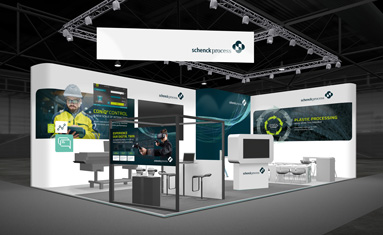Clinker Substitution through Cement Blending to Reduce Carbon Emissions
Argos Rio Claro, Colombia, owned and operated by its parent company Cementos Argos, wanted to achieve a higher clinker substitution rate for its Portland cement, by blending alternative cementitious materials. This substitution is helping to advance the company’s sustainability drive to achieve zero carbon emissions in concrete by 2050 or sooner. The resulting project involved construction of the world’s largest calcined clay kiln in operation to date, with a capacity of 1500 tons/day.
An operation of this type would normally require a complex system to manage, measure and mix materials with the level of accuracy required, yet Argos Rio Claro was able to manage its process updates with a compact system that simplified the process steps without sacrificing accuracy or efficiency.
The Challenges Posed by Calcined Clays
The company selected a natural pozzolanic ingredient for its formulation, calcined clay, and installed a production line with a capacity of up to 0.45 million metric tons/year.
The final product, a pozzolanic cement (PPC), is gentler on the environment, cutting CO2 emissions by 38% compared to traditional cement processing, and utilizing 30% less energy than ordinary Portland cement (OPC) production.
Mauricio Giraldo, Director of Combustible Alternatives for Argos Rio Claro said that as a rule, the cement industry prefers “proven technologies” when going to the market. This new project, building such a large, calcined clay kiln, involved several unknowns. Schenck Process’ expertise and experience led Argos to partner with them for the equipment necessary to make the transition.
Globally, several companies are working with calcined clays, said Dr. Giraldo. However, it presents a unique set of challenges, among them, the fact that the materials’ behavior is impossible to predict with 100% accuracy.
What is Pozzolan Cement?
The word “Pozzolana” comes from an Italian reference to volcanic powder found near Vesuvius. A natural pozzolan would be any source material of volcanic origin or a sedimentary clay and have been used as a binding material since the Roman empire. More recently a series of other materials have been found to have the ability to react with calcium hydroxide and thus the term Supplementary Cementitious Materials, or SCMs has come into play. SCM’s stem from industrial wastes or processed materials, such as artificial pozzolans, blast furnace slag, fly ash, or rice husk ash, for example. Cements made with SCM’s are governed by ASTM international standards.
PPC or Pozzolana Portland cement is made by mixing 20-30% pozzolana or SCMs with OPC. When mixed with water or lime, pozzolanic materials undergo a reaction with calcium hydroxide that forms compounds with cementlike properties.
Ordinary Portland cement is the most common type used in the industry, a mixture of limestone, gypsum, and a calcareous material. OPC has great initial strength when mixed and requires less curing time than PPC.
During its lifetime however, PPC has greater durability and workability, and it strengthens as it cures. In addition, PPC is more eco-friendly and, advantageous to the cement industry, has a lower cost of production than OPC because of its lower energy consumption.
The variety of materials in pozzolan dictates the necessity of careful metering and blending to achieve an end product with desired properties and behavior. Pozzolanic material reactivity is dependent on a variety of factors, such as individual particle size, material composition and temperature. Other considerations for a successful outcome include the composition of the parent material, constituent materials and curing times/procedures.
A pozzolan’s reaction time speeds up in proportion to higher temperatures or when used in conjunction with a high alkali Portland cement. The material that the Argos plant intends to use, calcined clay, will increase workability. Other factors involved in reaction time include water requirements and recalibration of the chemical admixture.
Investment in Sustainable Business Practices
Cementos Argos invested $78 million USD to convert this production line to the manufacturing and distribution of green cement. The manufacture of pozzolan cement is more environmentally friendly in part since the incorporation of calcined clays reduces the use of the clinker. The pozzolana/clinker ratio is critically important to its functionality. This is what leads to reduced CO2 emissions and lower energy consumption.
According to a review in the journal Materials, “Alternative Clinker Technologies for Reducing Carbon Emissions in the Cement Industry,” “the two main CO2 contributors in (the cement) produces are fossil fuel combustion to heat the rotary kiln and the chemical reaction associated with the calcination process, in the production of the clinker, the main component of OPC.”
It further stated that “the production of one ton of clinker releases about 0.83 tons of CO2 and the production of one ton of OPC releases about 0.54 ton of CO2. The fossil fuel combustion to heat the cement kiln is responsible for 35% to 40% of the emissions.”.
Pozzolanic materials in general, help create:
- Very fine Blaine size cement with low porosity
- This low porosity fills gaps between aggregates and reinforcement to reduce shrinkage or honeycomb formations, increasing the durability and strength of the end product
- An eco-friendly manufacturing process that uses industrial byproducts that would otherwise be discarded as ingredients within the cement mixture
- Material resistant to sulphate attacks, making it an excellent choice for hydraulic or marine structures, dam construction, etc.
- Reduces carbon dioxide emissions compared to OPC

World’s Largest Calcined Clay Kiln Relied on Schenck Process for Precise Metering and Blending
Schenck Process Answers the Challenges
Clinker substitution requires very accurate measurements due to differing substitution rates depending on the grind of various supplementary materials. It also requires a thorough mixture of these ingredient blends to achieve a homogeneous result, one that has been correctly dosed. Said Dr. Giraldo, “Each and every cubic inch of the material in a bag of cement needs to be the same—well mixed—in order to supply a viable product to the end user when building something.”
According to Dr. Giraldo, this usually involves a complicated equipment system. However, the representatives at Schenck Process submitted a proposal for a compact, simple system based on two MULTICOR® metering systems. This allowed Cementos Argos to install the most cost effective, accurate and efficient solution for its processing.

The Schenck Process Complete Solution Specifics
Cementos Argos in 2019 launched a new type of pozzolanic cement called “Cemento Verde.”.
The system Schenck Process designed was easy to install and fit within client specifications to minimize its plant footprint, accuracy, supply reliability and durability and require little maintenance.
Schenck Process’ technical knowledge proved critical to the operation’s success, especially considering its local service technicians in Colombia, and the fact that Schenck supplies a complete solution from design and engineering through commissioning.
The specific system parts Schenck Process supplied included a:
- MULTICOR® Coriolis flow meter
- Supervisory controls (DISOCONT® TERSUS)
- Slide valves
- Control valves
- Air slides
- Dust collectors
- Blowers
- Engineering drawings/designs
Of particular value to Argos was Schenck technology for flow measurement and mixing, in its MULTICOR®, a mass flowrate feeding/dosing metering device. This provides precise flow measurement according to the Coriolis principle. This is a unique measuring principle for bulk solids, independent of material property changes that can create errors in other measurement means.
The MULTICOR® measures the material stream with an accuracy of ±0.5%. Mass flows are exactly measured and fed in conjunction with an adjustable pre-feeder. This precision offers the plant 1) cost savings by supplying exact throughput and 2) a high value final product.
From start to finish, the project took six months from design to installation. The system was installed and has been operational since the beginning of 2020.
Future Rollout of Argos Approach
According to Dr. Giraldo “I want to see this type of system replicated because I believe it is going to be a game changer for the industry.”
He added, “It's overwhelming to go from a drawing to the site building and know that what you were planning to do actually worked. I was very proud to be involved with that team.”
Since installing the kiln in 2020, Schenck Process has supplied three more cement
metering and blending lines in North America and is in the process of engineering several others.
According to Miguel R. Suarez, Project Director for Cementos Argos, S.A., “The
blending systems (from Schenck) have shown very good behavior from a quality perspective due to the homogeneity we can achieve in the mixtures.”
Suarez listed some of the benefits the company realized working with Schenck:
- Cost reductions traced to optimizing cement mill production.
- Enhanced sustainability by reducing the cement’s carbon footprint by up to 38%.
- Improved cement quality due to the mixing process supplying a higher degree of accuracy and tight standard deviations compared to previous practices.
- Improved production flexibility. In line blending allows operators to rapidly change ratios and additives to meet market demand.
- Streamlined facility capacity planning due to production improvements, which also optimized storage facilities due to the speed of dispatch of finished products and better use of storage silos.
Downloads
Data sheets
Flow sheets
Specials / Studies
We’re there for you
Partnership for us means always being on hand to support you whenever and wherever you need us. With our global network of locations and expert partners, we make sure we are always right by your side.
Privacy settings
We use cookies to optimize our website’s functionality and continuously improve your experience.
Some types of cookies are essential to the technical functionality of our website.
Additional cookies are used only with your consent. In this context, we use Google Analytics in the anonymized version to access, analyze, and save information, such as the characteristics of your device and certain personal data (IP addresses, navigation usage, geolocation data, or unique identification features. (YouTube, FB, etc.))
With regard to the processing of your data in the USA by Google: By clicking on [“Agree to all”], you also consent to the processing of your data in the USA in accordance with Article 49 (1) (a) of the GDPR. According to the European Court of Justice’s current case law, the USA is assessed as a country with an inadequate level of data protection by EU standards. In particular, there is a risk that your data could be processed by US authorities without you becoming aware of it or having access to legal remedy. If you click on [“Save preferences”] without having selected “Analytics”, the transfer of data described above will not take place. Further information can be found in our data protection information.




-600x400.jpg)




